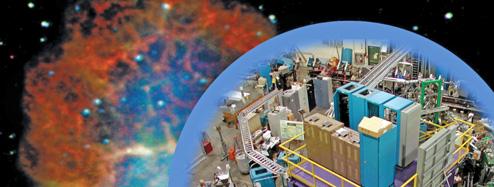
ISAC and DRAGON, the Detector of Recoils And Gammas Of Nuclear reactions, have combined for a successful run with a very challenging beam. DRAGON is the first facility to directly measure the 23Mg(p,g)24Al reaction rate, a key astrophysical milestone. DRAGON measures the rates of nuclear reactions that are important in astrophysics, particularly the reactions that made the elements around us. These nucleosynthesis reactions occur in novae, supernovae, and x-ray bursters. The reaction studied here is important for the production of the long-lived radioisotopes 22Na and 26Al in classical nova scenarios.
The success of the experiment was only possible with the combined efforts of the TRIUMF/ISAC beam delivery team that together produced the world’s most intense 23Mg beam with impressive availability. The radioactive species are first formed when 40 micro-amps of 500 MeV protons from the TRIUMF cyclotron strike a silicon-carbide target. The 23Mg atoms are then ionized (removing a single electron) with an array of finely tuned high-power lasers and accelerated across a 46 kV potential. The resulting ion beam is then further accelerated to the required reaction energy by the ISAC linear accelerators before being fired at the DRAGON hydrogen-gas target. The production method is complex but results in a beam of very high quality.
This important experiment is challenging since the reaction rate is extremely small and requires long running times with stable operating conditions. Constant optimization of the lasers was needed to maintain the beam properties. It was the first direct measurement of the 23Mg(p,g)24Al reaction ever attempted, and was made possible only by having access to the world's most intense and highest quality post-accelerated 23Mg beam.
Maria Jose Crousillat
TRIUMF's Communications Assistant
with assistance from R. Laxdal and A.C. Morton
